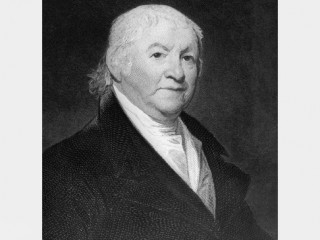
Paul Revere biography
Date of birth : 1735-01-01
Date of death : 1818-05-10
Birthplace : Boston, Massachusetts, United States
Nationality : American
Category : Famous Figures
Last modified : 2010-10-01
Credited as : Patriot, ,
18 votes so far
Listen my children and you shall hear / Of the midnight ride of Paul Revere, / On the eighteenth of April, in Seventy-five; / Hardly a man is now alive / Who remembers that famous day and year. / He said to his friend, "If the British march / By land or sea from the town to-night, / Hang a lantern aloft in the belfry arch / Of the North Church tower as a signal light,-- / One if by land, and two if by sea; / And I on the opposite shore will be, Ready to ride and spread the alarm / Through every Middlesex village and farm, / For the country folk to be up and to arm." -- Henry Wadsworth Longfellow, Paul Revere's Ride
Paul Revere (1735-1818) is best known as an American patriot during the American Revolution (1775-1783). He is the man who helped carry news of the approach of British troops to Lexington, Massachusetts, in what became known as Paul Revere's midnight ride. When Revere wasn't fighting for American independence, he was a creative and successful silversmith.
Paul Revere was born January 1, 1735 in Boston, Massachusetts. He was the third of twelve children born to Apollos De Revoire, a Frenchman. De Revoire changed the family name to Revere to make it easier for Americans to pronounce. Apollos De Revoire was a silversmith and he taught the trade to his son.
Paul Revere married Sarah Orne in 1756 after serving for a short time in the French and Indian War (1754-1763). At age twenty-one he began work in his father's silversmith business. Revere was a talented silversmith and an innovator in processing commercial-grade bronze and copper. His skills made him a success in his trade.
In his early years as a silversmith Revere developed an intense interest in the issue of American independence from England. He became involved in revolutionary activities and attracted wide public attention when he used his engraving skills to create a number of political cartoons aimed at the issue of independence.
Revere began to work closely with revolutionary leaders, such as Samuel Adams (1722-1803) and John Hancock (1737-1793). He also participated in the famous Boston Tea Party on December 16, 1773. He and other Boston protestors raided a British ship in Boston harbor and dumped the tea cargo into the ocean, dissenting against British taxes in the colonies. This protest was one of the crucial events leading up to the American Revolution (1775-1783).
In addition to his activities as a revolutionary, Revere directed his energies to a variety of areas. He pursued work on a wide-ranging field, from working with silver to the manufacture of gunpowder. In Massachusetts he created a mill that ground wheat and oats by using the swirling flow of river water to move grindstones. He designed and printed the first issue of U.S. paper money and was the first in the United States to discover the process of rolling sheet copper. In Canton, Massachusetts, he built the first copper-rolling mill in the country.
Revere was continually involved in the politics of his new nation. He served as an activist, a soldier, and a political thinker. He achieved great success as a silversmith and expanded his business efforts towards growing U.S. industries. Paul Revere was an entrepreneur and a patriot. He died in 1818.
















